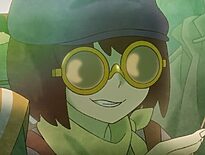Directed by Shinnosuke Yakuwa, filled with celebrity voices and based on the autobiography Totto-chan: The Little Girl at the Window by Tetsuko Kuroyanagi, the Totto-chan anime had its UK premiere in Glasgow and then aired again in Edinburgh for Scotland Loves Anime.
I’m calling this a bittersweet anime because even though the story follows Japan into the horrors of World War II, there are moments of absolute tenderness. These moments come from the titular character in the autobiography and have to be forgiven. Tetsuko Kuroyanagi is a TV talk show goddess in Japan, approaching 50 years on the box. That’s like two Terry Wogans in one.
In my youth, I would have described the young Totto-chan as precocious. Today, I hope, I’d recognise her as neurodivergent. In pre-war Japan, the authorities called her a troublemaker. Fortunately, Tetsuko was placed in an accommodating school, which set her on the right track.
Tracks, especially trains, play a key role in this story. The script starts with a train; her classroom is a train, and when we last see Totto-chan, she grows up on a train.
Totto-chan look and feel

Totto-chan is a visually charming anime film with a nostalgic and heartwarming aesthetic. The animation style is reminiscent of classic children’s book illustrations, with soft lines, warm colours, and expressive characters. At times, little Totto-chan has a round face that reminds me of Betty Boop, and at other times, when emotions are high, Totto-chan’s face is almost a caricature of expression.
The backgrounds are often detailed and evocative, capturing the beauty of nature and the quaintness of 1940s Tokyo. It’s amazing, frustrating, and awkward to see how European it was at times.
The film’s overall feel is one of gentle optimism and childlike wonder. The animation is fluid and expressive, capturing the energy and curiosity of Totto-chan, the young protagonist. The (often) cheerful and whimsical music enhances the film’s lighthearted and nostalgic tone. Scotland Loves Anime host Jonathan Clements, who has written a book on the subject, was also able to alert the audience to the significance of certain songs used by Japanese radio ahead of bad news and these feature here.
Though it addresses serious themes such as war and loss, the film retains a sense of hope and resilience, showcasing Totto-chan’s steadfast optimism and the transformative power of education. Her life would have been drastically different without her teachers.
Totto-chan plot and characters

I think Totto-chan really is about the strength of will to be curious, happy and most of all – empathic – in the face of a life full of hardship. Life isn’t fair.
There’s a scene in which young Totto-chan drops her purse down the toilet and into a 1930s sewer. The determined youngster gets a pan on a stick and begins to dig for it. You can imagine the mess! And yet, she looked. She didn’t give up. It’s a scene that defines the girl for me.
Headmaster Sosaku Kobayashi outsides Totto-chan’s valiant parents as the star. Without him, neither Totto-chan nor a dozen other kids would have had very good lives.
We stay with Kobayashi and the school for most of the anime, and we get there fairly quickly as Totto-chan’s energy gets her expelled from her previous school pretty quickly.
Overall
Totto-chan: The Little Girl at the Window is a heartwarming anime film that celebrates the wonder and innocence of childhood with bittersweet innocence. The story follows Totto-chan, a young girl with a unique perspective, as it explores themes of acceptance, individuality, and the importance of nurturing a child’s curiosity. With its charming animation and touching narrative, Totto-chan is a delightful film for viewers of most ages although the finer details will be lost on youngsters.
🍻 Sponsor: Cheers, Dusk Wave Arts and Barheim, the beer tower defence game, for enabling our Scotland Loves Anime trip.


